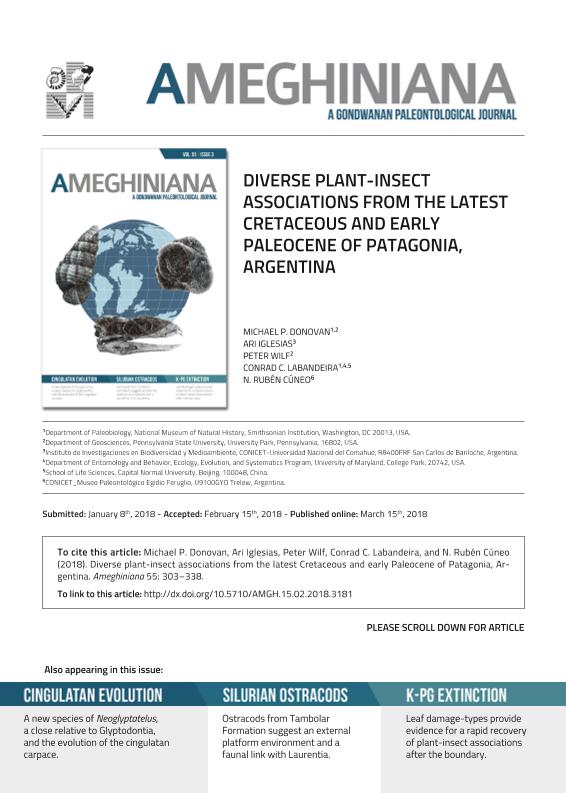Mostrar el registro sencillo del ítem
dc.contributor.author
Donovan, Michael P.
dc.contributor.author
Iglesias, Ari

dc.contributor.author
Wilf, Peter
dc.contributor.author
Labandeira, Conrad
dc.contributor.author
Cúneo, Néstor Rubén

dc.date.available
2020-04-13T17:10:33Z
dc.date.issued
2018-10
dc.identifier.citation
Donovan, Michael P.; Iglesias, Ari; Wilf, Peter; Labandeira, Conrad; Cúneo, Néstor Rubén; Diverse plant-insect associations from the latest Cretaceous and early Paleocene of Patagonia, Argentina; Asociación Paleontológica Argentina; Ameghiniana; 55; 3; 10-2018; 303-338
dc.identifier.issn
0002-7014
dc.identifier.uri
http://hdl.handle.net/11336/102390
dc.description.abstract
Little is known about the recovery of terrestrial ecosystems after the end-Cretaceous extinction outside of the Western Interiorof North America, relatively close to the 66 Ma bolide impact crater in Chicxulub, Mexico. A previous report showed that in Patagonia, Argentina,insect damage on fossil leaves decreased from the latest Cretaceous to early Paleocene but recovered to pre-extinction levelswithin ca. four million years. Here, we present the first detailed study of these Patagonian plant-insect associations, key componentsof terrestrial food webs, during the latest Cretaceous and three time slices from the early Paleocene recovery. The lithologic units studiedare the uppermost Cretaceous portion of the Lefipán Formation and the Danian Salamanca and Peñas Coloradas formations in Chubut,Argentina. Seven functional feeding groups are present throughout: hole feeding, margin feeding, skeletonization, surface feeding, piercingand sucking, mining, and galling. Fifty damage types (DTs) were present at Maastrichtian localities, and 39?48 were found at Danian localities.Plant-insect associations that apparently went locally extinct at the end of the Cretaceous include several gall, mine, and piercingand-sucking DTs. Based on our preliminary leaf morphotypes, host plants did not provide refuge for specialized insect herbivores across theK/Pg boundary. Despite a decrease in insect damage diversity after the bolide impact, Danian floras hosted a rich array of DTs, including specializeddamage such as mines and galls. Many of these early Paleocene DTs were not found in the terminal Cretaceous, providing evidencefor a rapid recovery of plant-insect associations regionally.
dc.format
application/pdf
dc.language.iso
eng
dc.publisher
Asociación Paleontológica Argentina

dc.rights
info:eu-repo/semantics/openAccess
dc.rights.uri
https://creativecommons.org/licenses/by-nc-sa/2.5/ar/
dc.subject
plant-insects
dc.subject
herbivory
dc.subject
gondwana
dc.subject
paleobotany
dc.subject.classification
Paleontología

dc.subject.classification
Ciencias de la Tierra y relacionadas con el Medio Ambiente

dc.subject.classification
CIENCIAS NATURALES Y EXACTAS

dc.title
Diverse plant-insect associations from the latest Cretaceous and early Paleocene of Patagonia, Argentina
dc.type
info:eu-repo/semantics/article
dc.type
info:ar-repo/semantics/artículo
dc.type
info:eu-repo/semantics/publishedVersion
dc.date.updated
2020-02-18T16:15:53Z
dc.identifier.eissn
1851-8044
dc.journal.volume
55
dc.journal.number
3
dc.journal.pagination
303-338
dc.journal.pais
Argentina

dc.journal.ciudad
Buenos Aires
dc.description.fil
Fil: Donovan, Michael P.. State University of Pennsylvania; Estados Unidos
dc.description.fil
Fil: Iglesias, Ari. Consejo Nacional de Investigaciones Científicas y Técnicas; Argentina. University of Maryland; Estados Unidos
dc.description.fil
Fil: Wilf, Peter. State University of Pennsylvania; Estados Unidos
dc.description.fil
Fil: Labandeira, Conrad. Capital Normal University; China. University of Maryland; Estados Unidos
dc.description.fil
Fil: Cúneo, Néstor Rubén. Consejo Nacional de Investigaciones Científicas y Técnicas; Argentina. Museo Paleontológico Egidio Feruglio; Argentina
dc.journal.title
Ameghiniana

dc.relation.alternativeid
info:eu-repo/semantics/altIdentifier/url/http://www.ameghiniana.org.ar/index.php/ameghiniana/article/view/3181
Archivos asociados
